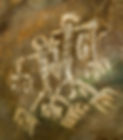Who were the early settlers of Kiritimati Island?
- Admin
- Oct 11
- 3 min read


Let’s take a trip to Kiritimati Island, also known as Christmas Island, the world's largest atoll. Kiritimati is one of the islands in Kiribati, located about 2,500 kilometers south of Hawaii.
The first European contact was in 1777 when English navigator Capt. James Cook discovered the island. He arrived on Christmas Eve, thus naming it “Christmas Island.” The island’s name changed to Kiritimati in 1979 when Kiribati, formerly known as the “Gilbert Islands,” gained independence from the United Kingdom.
Cook didn’t find human settlers when he arrived on the island. He only saw fish, birds and rats. Kiritimati Island was dry, with scarce vegetation and only about 30 coconut trees scattered around. There was a vast lagoon, but freshwater was almost impossible to find. There were no rivers or lakes with freshwater on the surface.
In 1836, the whaling ship Briton ran aground on Kiritimati Island. Its crew survived seven months with what supplies they had from the ship, catching a few turtles and relying on what little water they could find.
The sailors also noticed stone piles that might have been old markers or cairns from earlier sailors who died there.
So when did the first settlers arrive and where did they come from?
American anthropologist Kenneth Emory, who visited Kiritimati Island in 1924, created the first detailed record of numerous archaeological sites found on the island.
A subsequent study was published in 2000 by archaeologists Atholl Anderson, Paul Wallin, Helene Martinsson-Wallin, Barry Fankhauser and Geoffrey Hope in the Journal of the Polynesian Society. The study, titled “Towards a First Prehistory of Kiritimati (Christmas) Island, Republic of Kiribati,” was the result of a three-week field research the year before the publication.
The archaeologists studied Kiritimati to determine when the first settlers arrived. They focused on sand plains, dunes, beaches and old lagoon shores, as well as places most likely to have been settled. They excavated six sites and radiocarbon dated small pieces of charcoal to find clues about the age of settlement.
The research team found that most plants on the island were short-lived shrubs, suggesting that the early settlers had limited firewood and had no extensive forests to rely on.
The archeologists studied the structures on sites. Despite the limited artifacts, they discovered some structures that provided clues about their cultural origins. One example was a tall rectangular platform that resembled a ceremonial ahu in the Society Islands. Other archeological sites had slab-built structures similar to the ceremonial platforms in the Tuamotu and northern Cook Islands. The authors noted that these links suggested connections with the central and northern parts of East Polynesia.
The basalt stones on the island also provided clues to the past. The rocks’ chemical composition indicated that they most likely came from either Hawaii or Samoa, establishing the theory that the first settlers were from these regions and brought materials such as stones with them.
However, the authors did not rule out central East Polynesia and Samoa as the origin of the first settlers. The Northeast trade winds could have easily brought canoes to Kiritimati from islands within 500 kilometers of each other.
According to the authors, evidence from radiocarbon dating indicated that the settlement period was around A.D. 1200-1600.
The early settlers relied mainly on fish, turtles and seabirds for sustenance. Due to limited freshwater, it was difficult for them to grow crops.
In the early 1900s, Father Emmanuel Rougier, a Catholic missionary, explored the island and found stone tombs, graves and a marae, or ceremonial platform. Rougier also found stone tombs with ashes nearby, as well as stone-lined structures that he assumed were the village remains. Rougier leased the island and planted coconuts for trade.
In 1907, Rougier reportedly got involved in the “Cecile Affair.” Stories had it that he supported an escaped French convict known as “Cecille,” who repaid him with a substantial amount of money. Rougier invested the money in the coconut plantation business. By 1913, there were about 750,000 coconut trees on the island, which had only about 30 trees when Cook discovered it.
Kiritimati Island is a remarkable example of how early Pacific settlers overcame challenges and adapted to harsh environments by relying on natural resources and maintaining cultural connections across thousands of kilometers of open sea.
Raquel Bagnol is a longtime journalist. She worked as a reporter for Marianas Variety on Saipan and Island Times in Palau. Send feedback to gukdako@yahoo.com
Subscribe to
our digital
monthly edition



